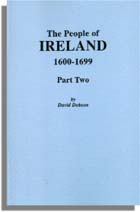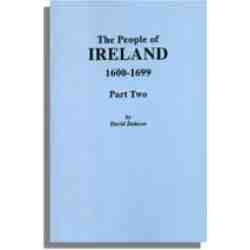People of Irish origin face a challenging task when they attempt to trace their early roots. Church records in Ireland, such as registers of baptism, marriage, and burial, which are so essential to research elsewhere in the British Isles, are hardly comprehensive. For example, very few Catholic Church registers are extant prior to the mid-18th century. The earliest ones, though incomplete, exist for the town of Wexford from 1671. There are a few Church of Ireland registers but most date from around 1770. The vast majority of Presbyterian churches date from the 1670s. (On the other hand, the Society of Friends [Quakers] has maintained excellent records dating from the mid-17th century.)
Family historians seeking their Irish roots of the 17th century are, therefore, faced with using a wide range of alternative source material, both published and manuscript. Much of this is original material in Ireland not accessible to the ordinary researcher, while some of the publications can be located in only a few specialist libraries, such as The National Library of Ireland in Dublin or the Public Record Office of Northern Ireland in Belfast. It is these impediments that David Dobson’s new series, The People of Ireland, 1600-1699, attempts to circumvent.
This work draws on primary sources, such as published government records, together with references found in Irish, English, Scottish, and Dutch archives. The single most important source used in this work is the series of published Calendar of State Papers relating to Ireland. Published in London between 1860 and 1910, the many volumes of this series contain a storehouse of genealogical information for the period 1509 to 1670. Included among the documents are letters and petitions from English officers, noblemen, native Irish chieftains, and mayors and corporations of towns in Ireland to the Lord Lieutenant of Ireland.
The aim of this series, now in its second volume, is to provide information on ordinary people throughout 17th-century Ireland–with the exception of people of Scottish origin who have been dealt with in Dr. Dobson’s Scots-Irish Links, 1575-1725 series. Thus, the people listed here are predominantly of native Irish and immigrant English origin, as well as a handful of Huguenot and Dutch immigrants. For Part Two, Dr. Dobson provides sketches of about 1,800 additional inhabitants of Ireland, bringing the grand total so far uncovered in the series to 3,200. Following are several illustrations from Part Two, minus the source citations:
Allen, Sir Joshua, co-owner of the Arran of Dublin, which was seized by the Governor of Malaga in 1684.
McSwiney, Brien Mcowen, of Cloheda, County Cork, a petition, 1611.
Staples, Lieutenant Colonel Alexander, leased the lands of Aighanlow and Faughan Vale in the bishopric of Derry, in 1614.
Wilson, William, an undertaker in Liffer, with his wife, children and family, 1612.


